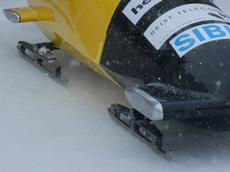The unspectacular sliders
Optimal runners are one of the essential factors for a successful bobsled. However, there is not much latitude for improving their surface texture. The only way to gain hundredths of a second is through modifying the shape of the runner itself.

Scarcely any attention is paid to them because they are practically invisible and also entirely unspectacular in operation: the bobsled’s runners—completely overshadowed in the truest sense of the word by the colorful stylish housing. Nevertheless they are a decisive factor in deciding whether the run is successful. The secrecy surrounding the alloy of the steel runners and the stringent rules to which they are subject are the only things that give any indication of how important they are for a victory.
Monopoly in the hands of the Swiss
There is only one company in the whole world that makes runners for bobsleds. This ensures that all bob producers have the same starting conditions. The Kohler Company, headquartered in Switzerland, supplies standardized steel for runners to all the bob constructors. This is why the Citius project team, which is building the Swiss bob for the Winter Olympics in Vancouver in a collaboration between ETH Zurich, industry and the Swiss Bobsleigh Federation, also purchased its runner steel from them. It involves plates whose hardness is between 35 and 37 Rockwell. The harder the steel, the higher the speeds that can be reached. However, it is not permissible for the runners to be hardened subsequently, e.g. by heating. A special adhesive label applied to the side of the steel and which would discolor if heated ensures that this does not occur secretly. The types of machining, i.e. how the runner blades are milled from the steel plates and ground, are the only things that can help the bob drivers to be slightly faster than the competition. Reto Grüebler of the Institute of Virtual Manufacturing studies how this runner geometry can be optimized within the specified framework.
The “Steel on Ice” project
The dimensions, geometry and attachment of the runners to the bob are also strictly regulated. “That’s why the latitude that we have is very small,” explains Nicholas Spencer, Professor of Surface Science and Technology at the Department of Materials and Director of the Citius “Steel on Ice” project team. He says that formerly, during the era of the GDR, which was practically unbeatable in the sport of bobsleigh racing, runners were successfully hardened by ion implantation, but that is all forbidden nowadays. A coating or other surface treatment is also hopeless in practice because the judges grind the runners down slightly before the race laps.
“One must try to optimize the friction,” explains Grüebler. Steel components machined in various ways were tested down to minus twenty degrees centigrade on what is known as the ice tribometer at the Swiss Federal Commission for Snow and Avalanche Research in Davos, with which friction and wear can be measured. Experiments with different surface finishes were also carried out at the same time. Spencer says: “However, it became apparent that this had practically no effect on the slipperiness.” Since the friction depends on the pressure, attention was paid mainly to when it is a minimum. “This depends in turn on the failure of the ice, i.e. when it breaks, and its deformability,” explains Grüebler. Spencer stresses that the formation of an optimum lubricating film, which is formed by pressure and friction and by melted ice, is of the greatest importance.
Modeling the Whistler Track
However, the “Steel on Ice” team went much further in its optimization experiments. They took the track data of the Whistler ice track in Vancouver, on which the Olympic bobsled competition will be held, and attempted to simulate a pressure profile of the bob over the whole winding section. That proved not to be so simple, however, and a three-dimensional simulation as originally planned was much too complex and laborious. As a result they were then forced to simplify their model significantly, for example by simulating only the cross-section of the runners and assuming rigid properties for the ice and the runner blades.
Using the data obtained in this way, the researchers studied how great the bob’s pressure on the ice will be at each point, and how deeply the runners will penetrate into the ice. Based on the data obtained, the team developed a computer-aided design plan, a CAD model, with which the runners can be fabricated industrially. However, since they are designed specifically for Whistler, they have not yet been used in the test runs up to now. Only when the bob travels abroad for the start of the next season will it become apparent how successful the runner research was.







READER COMMENTS